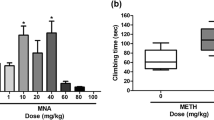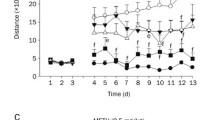Abstract
Dose-dependent effects of 7-OH-DPAT on several behaviors, including place preference, were assessed. Three 2-day conditioning trials were conducted. On 1 day, animals received an injection of one of eight doses of 7-OH-DPAT (0–5 mg/kg) and were placed into a distinct compartment for 40 min. On the other day, animals received an injection of saline and were placed into a different compartment for 40 min. Locomotion, sniffing, and yawning were measured following the first and last injection of 7-OH-DPAT. Place conditioning was assessed on the day following the last trial. 7-OH-DPAT produced a U-shaped dose-dependent change in locomotion and sniffing, and an inverted U-shaped dose-dependent change in yawning. Additionally, repeated administration of 0.1 mg/kg sensitized yawning, whereas 5 mg/kg sensitized locomotion. None of the doses of 7-OH-DPAT produced conditioned place preference, however, there was a trend for conditioned place aversion at 0.03 mg/kg. By contrast, LiCl (127 mg/kg) produced conditioned place aversion and amphetamine (1 mg/kg) produced conditioned place preference using the same conditioning parameters. A subsequent experiment in which the number of animals and conditioning trials were increased demonstrated that the 0.03 mg/kg dose of 7-OH-DPAT produced conditioned place aversion. 7-OH-DPAT has a higher affinity for D3 receptors relative to D2 receptors. Therefore, it is suggested that intermediate doses (0.01–0.1 mg/kg) that increase yawning, and decrease locomotion and sniffing, may preferentially occupy D3 receptors. Furthermore, the results suggest that these putative D3-preferring doses have weak aversive effects.
Similar content being viewed by others
References
Booth RG, Baldessarini RJ, Marsh E, Owens CE (1994) Actions of (+)-7-hydroxy-N-N-dipropylaminotetralin (7-OH-DPAT) on dopamine synthesis in limbic and extrapyramidal regions of rat brain. Brain Res 662:283–288
Caine SB, Koob GF (1993) Modulation of cocaine self-administration in the rat through D-3 dopamine receptors. Science 260:1814–1816
Carlsson A (1975) Receptor-mediated control of dopamine metabolism. In: Usdin E, Synder S (eds) Pre- and postsynaptic receptors. Dekker, New York pp 49–63
Daly SA, Waddington JL (1993) Behavioural effects of the putative D-3 dopamine receptor agonist 7-OH-DPAT in relation to other “D-2-like” agonists. Neuropharmacology 32:509–510
Damsma G, Bottema T, Westerink BHC, Tepper PT, Dijkstra D, Pugsley TA, Mackenzie RG, Heffner TG, Wikström H (1993) Pharmacological aspects ofR-(+)-7-OH- DPAT, a putative dopamine D3 receptor ligand. Eur J Pharmacol 249:R9-R10
De Fonseca FR, Rubio P, Martín-Calderón JL, Caine SB, Koob GF, Navarro M (1995) The dopamine receptor agonist 7-OH-DPAT modulates the acquisition and expression of morphine-induced place preference. Eur J Pharmacol 274:47–55
Hoffman DC (1989) The use of place conditioning in studying the neuropharmacology of drug reinforcement. Brain Res Bull 23:373–387
Hoffman DC, Beninger RJ (1989) The effects of selective dopamine D1 or D2 receptor antagonists on the establishment of agonist-induced place conditioning in rats. Pharmacol Biochem Behav 33:273–279
Kostrzewa RM, Brus R, Rykaczewska M, Plech A (1993) Lowdose quinpirole ontogenically sensitizes to quinpirole-induced yawning in rats. Pharmacol Biochem Behav 44:487–489
Lévesque D, Diaz J, Pilon C, Martres M, Giros B, Souil E, Schott D, Morgat J, Schwartz J, Sokoloff P (1992) Identification, characterization, and localization of the dopamine D3 receptor in rat brain using 7-[3H]hydroxy-N,N-di-n-propyl-2-aminotetralin. Proc Natl Acad Sci USA 89:8155–8159
Mallet PE, Beninger RJ (1994) 7 OH-DPAT produces place conditioning in rats. Eur J Pharmacol 261:R5-R6
Mattingly BA, Rowlett JK, Lovell G (1993) Effects of daily SKF 38393, quinpirole, and SCH 22390 treatments on locomotor activity and subsequent sensitivity to apomorphine. Psychopharmacology 110:320–326
McElroy JF (1994) Discriminative stimulus properties of 7-OH-DPAT, a dopamine D3-selective receptor ligand. Pharmacol Biochem Behav 48:531–3
Neisewander JL, Lucki I, McGonigle P (1991) Behavioral and neurochemical effects of chronic administration of reserpine and SKF-39383 in rats. J Pharmacol Exp Ther 257:850–860
Sibley DR, Monsma JR (1992) Molecular biology of dopamine receptors. Trends Pharmacol Sci 13:61–69
Sokoloff P, Giros B, Martres M, Bouthenet M, Schwartz J (1990) Molecular cloning and characterization of a novel dopamine receptor (D3) as a target for neuroleptics. Nature 347:146–151
Svensson K, Carlsson A, Waters N (1994) Locomotor inhibition by the D3 ligandR-(+)-7-OH-DPAT is independent of changes in dopamine release. J Neural Transm 95:71–74
Van den Buuse M (1993) Effects of 7-hydroxy-N,N-di-n-propylaminotetralin on behaviour and blood pressure of spontaneously hypertensive rats. Eur J Pharmacol 243:169–77
Waters N, Svensson K, Haadsma-Svensson SR, Smith MW, Carlsson A (1993) The dopamine D3-receptor: a postsynaptic receptor inhibitory on rat locomotor activity. J Neural Transm 94:11–19
White FJ, Hu XT, Brooderson RJ (1990) Repeated stimulation of dopamine D-1 receptors enhances the effects of dopamine receptor agonists. Eur J Pharmacol 191:497–499
Author information
Authors and Affiliations
Rights and permissions
About this article
Cite this article
Khroyan, T.V., Baker, D.A. & Neisewander, J.L. Dose-dependent effects of the D3-preferring agonist 7-OH-DPAT on motor behaviors and place conditioning. Psychopharmacology 122, 351–357 (1995). https://doi.org/10.1007/BF02246265
Received:
Revised:
Issue Date:
DOI: https://doi.org/10.1007/BF02246265




